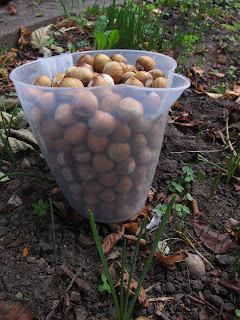Back from a weekend in Somerset with A's family and with a gift of four foxglove plants from the family garden. When we moved to the house most of the plants in the path border had already flowered and gone over. In amongst the azalea I found a single spike of something, full of tiny brown black seed, which I collected in a twist of brown paper and optimistically labelled "foxglove".
I'm usually one for muted pastel colours in the garden but in a foxglove I can tolerate the blowsiest of fuschias. I love watching the bumble bees busy in and out of the tubular flowers and was looking forward to bulking up my solitary foxglove with some baby plants that would bloom over the Summer. Casually mentioning my plans over the weekend I was more than a bit disappointed to learn that foxgloves are biennials and I wouldn't be seeing flowers for another year. However, the disappointment didn't last for long because I left with four healthy foxglove plants which had self-seeded into a border the year before; these I planted into the shadiest end of my garden in a small drift with the hope that they will self-seed some more.
Monday, 26 September 2011
Monday, 19 September 2011
An evening's work
Yesterday evening was so lovely, warm and light that my quick potter in the garden quickly turned into a full on tackle with an overgrown flower bed. The bed in question sits under our window and is filled with japanese anemones. Back in July, when we moved in, I had my first encounter with these plants, green luscious ground cover from which shot up elegant nodding stems topped with fat siver and brown buds. They were so beautiful that it was a disappointment when they flowered, a girly pink with yellow centres that were too pretty pretty and twee for my tastes. But I grew to love the way they filled the space under the window and, in a garden that had gone over by July, they kept going and going and had earned my respect.
All things pass and, by last week, the anemones had exhausted themselves, falling over into the path in one big knot of stems and spent heads, and I was desperate to tackle them. Five minutes and a few snips later the bed was cleared down to single small clump with a smaller chain of baby plants and a broken solar powered light that had been completely engulfed by the foliage. Before I knew it I was digging up the bed, putting the larger clump to one side, and tackling the huge dandelions lurking behind before digging in manure and replanting.
The finished results are in the photo. I was so pleased that I kept popping my head out of the door to take another look. This garden is such a huge task to take on, starting and finishing one small bed in an evening was a real pleasure.
Labels:
existing garden,
japanese anemones,
project
Monday, 12 September 2011
Katia & Hugh
The tail end of hurricane Katia has arrived in Warwickshire resulting in a bumper windfall of hazelnuts. On the way to put out the recycling in the morning I saw them scattered around and dashed back, grabbing my improvised watering can (plastic jug from Wilkinsons). I collected a jug-and-a-half-full on my first scour (still in flip flops and jogging bottoms when the neighbours walked past the gate). By lunch time another handful had fallen and every time we came into the garden more fresh hazelnuts strew the path.
As it happens, this weekend in the Guardian magazine Hugh Fearnley Whittingstall based his recipe column on hazelnuts so we have a selection of very tasty recipes to try out. With so many hazelnuts to get through I’m thinking of making a few batches of the honeyed hazelnuts for family Christmas gifts, but the hazelnut meringues are all for us! The recipes are here if you are lucky enough to have your own glut of nuts: http://bit.ly/pGQmCL
My conscience told me to leave some for the squirrels to nibble on but this Summer I have been waging a war on last year’s hazelnuts, having sprouted up and down the borders that frame the path. Their roots head straight down into the ground; even the smallest take some uprooting. In the end there were so many nuts around the path and beds that I left any beyond easy reach for the wildlife to enjoy –any saplings should remain safely tucked under the parent tree.
Subscribe to:
Posts (Atom)







